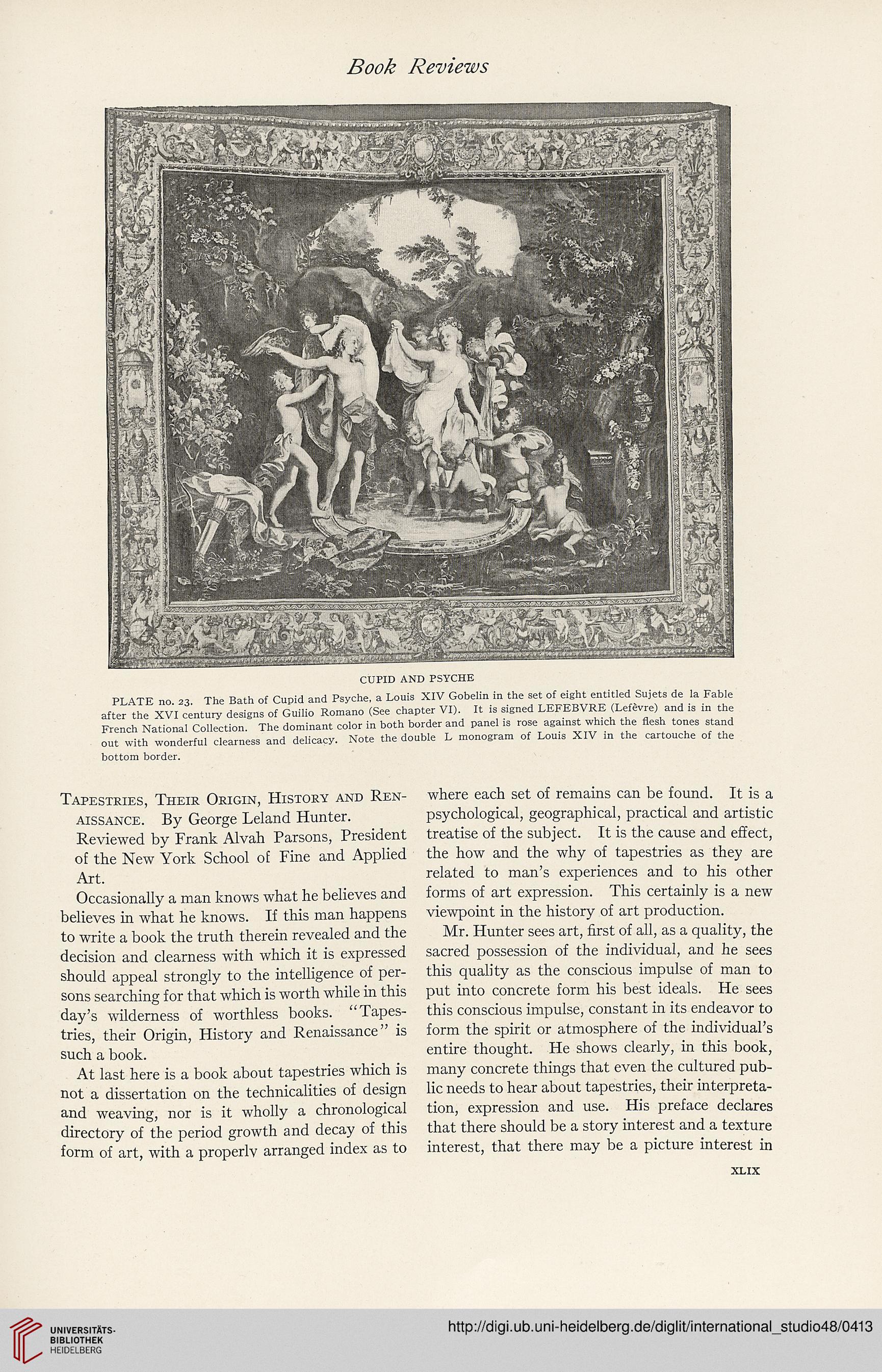Book Reviews
CUPID AND PSYCHE
PLATE no. 23. The Bath of Cupid and Psyche, a Louis XIV Gobelin in the set of eight entitled Sujets de la Fable
after the XVI century designs of Guilio Romano (See chapter VI). It is signed LEFEBVRE (Lefevre) and is in the
French National Collection. The dominant color in both border and panel is rose against which the flesh tones stand
out with wonderful clearness and delicacy. Note the double L monogram of Louis XIV in the cartouche of the
bottom border.
Tapestries, Their Origin, History and Ren-
aissance. By George Leland Hunter.
Reviewed by Frank Alvah Parsons, President
of the New York School of Fine and Applied
Art.
Occasionally a man knows what he believes and
believes in what he knows. If this man happens
to write a book the truth therein revealed and the
decision and clearness with which it is expressed
should appeal strongly to the intelligence of per-
sons searching for that which is worth while in this
day’s wilderness of worthless books. “Tapes-
tries, their Origin, History and Renaissance” is
such a book.
At last here is a book about tapestries which is
not a dissertation on the technicalities of design
and weaving, nor is it wholly a chronological
directory of the period growth and decay of this
form of art, with a properly arranged index as to
where each set of remains can be found. It is a
psychological, geographical, practical and artistic
treatise of the subject. It is the cause and effect,
the how and the why of tapestries as they are
related to man’s experiences and to his other
forms of art expression. This certainly is a new
viewpoint in the history of art production.
Mr. Hunter sees art, first of all, as a quality, the
sacred possession of the individual, and he sees
this quality as the conscious impulse of man to
put into concrete form his best ideals. He sees
this conscious impulse, constant in its endeavor to
form the spirit or atmosphere of the individual’s
entire thought. He shows clearly, in this book,
many concrete things that even the cultured pub-
lic needs to hear about tapestries, their interpreta-
tion, expression and use. His preface declares
that there should be a story interest and a texture
interest, that there may be a picture interest in
XLIX
CUPID AND PSYCHE
PLATE no. 23. The Bath of Cupid and Psyche, a Louis XIV Gobelin in the set of eight entitled Sujets de la Fable
after the XVI century designs of Guilio Romano (See chapter VI). It is signed LEFEBVRE (Lefevre) and is in the
French National Collection. The dominant color in both border and panel is rose against which the flesh tones stand
out with wonderful clearness and delicacy. Note the double L monogram of Louis XIV in the cartouche of the
bottom border.
Tapestries, Their Origin, History and Ren-
aissance. By George Leland Hunter.
Reviewed by Frank Alvah Parsons, President
of the New York School of Fine and Applied
Art.
Occasionally a man knows what he believes and
believes in what he knows. If this man happens
to write a book the truth therein revealed and the
decision and clearness with which it is expressed
should appeal strongly to the intelligence of per-
sons searching for that which is worth while in this
day’s wilderness of worthless books. “Tapes-
tries, their Origin, History and Renaissance” is
such a book.
At last here is a book about tapestries which is
not a dissertation on the technicalities of design
and weaving, nor is it wholly a chronological
directory of the period growth and decay of this
form of art, with a properly arranged index as to
where each set of remains can be found. It is a
psychological, geographical, practical and artistic
treatise of the subject. It is the cause and effect,
the how and the why of tapestries as they are
related to man’s experiences and to his other
forms of art expression. This certainly is a new
viewpoint in the history of art production.
Mr. Hunter sees art, first of all, as a quality, the
sacred possession of the individual, and he sees
this quality as the conscious impulse of man to
put into concrete form his best ideals. He sees
this conscious impulse, constant in its endeavor to
form the spirit or atmosphere of the individual’s
entire thought. He shows clearly, in this book,
many concrete things that even the cultured pub-
lic needs to hear about tapestries, their interpreta-
tion, expression and use. His preface declares
that there should be a story interest and a texture
interest, that there may be a picture interest in
XLIX




